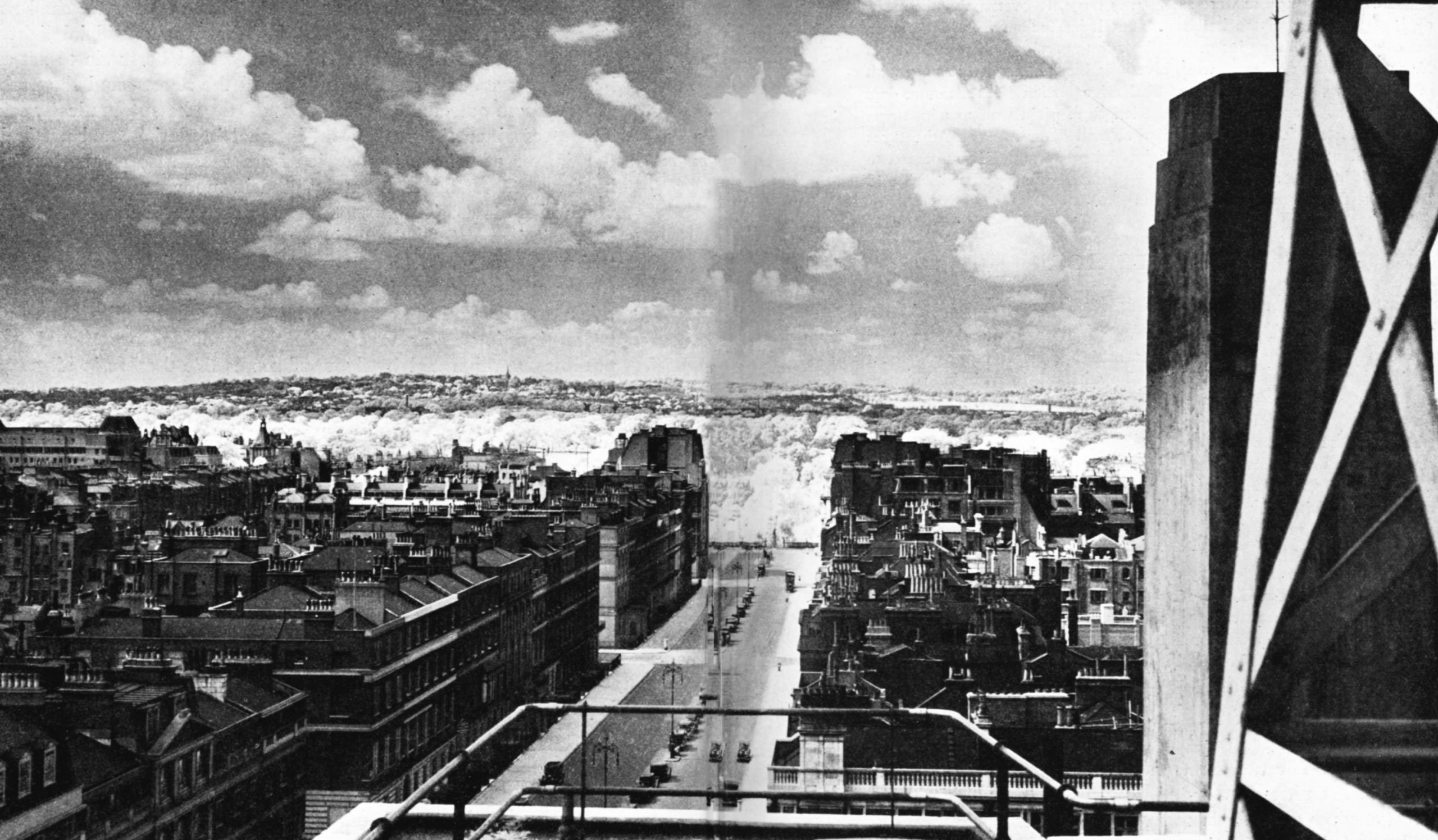The exterior
Describing the exterior of the building, Professor Reilly says:
The architect has taken the big curved front to Portland Place and modelled it in a series of flat vertical planes rising sheer from the pavement but balanced about a central axis. The windows in their long ranges emphasize admirably the curve of the front. Probably out of sympathy for the surrounding buildings, he has not turned them into long continuous sheets of glass in the modern way, but has given each the ordinary vertical shape. He has even filled them with bars, in these days of plate glass, to obtain a contrasting texture with his plain stone surfaces. These great stone cliffs of his, rising, as it were, one behind the other from a base modulated by a range of larger windows, a band of wave ornament, and a central strongly marked balcony, but with no crowning cornice, give an aspiring look to the building well in keeping with its central function.
Such ornament as there is, the decorative coat of arms and the interesting frieze of birds and rays of light on the balcony front, designed by the architect, and the impressive reliefs by Mr. Eric Gill at the base of the two bays flanking the Portland Place front, are, like the building itself, restrained and forceful.
A distinctive feature of the elevation is the group of aerial masts which undoubtedly help the building to express its function in an obvious manner. The two masts on the highest part of the roof carry the aerial of the ultra-short-wave transmitter with which the B.B.C. is at present conducting experiments. The third mast on the lower roof at the front of the building is a spare one. Small receiving aerials are slung in various places on the roof, their positions being altered experimentally from time to time.
There are four flagstaffs on the building, two on the western side at the eighth floor level, and two spare ones on the eastern at the fourth floor level, where the roof begins to recede. The flagstaff at the north-west corner flies the Union Jack, that at the south-west the B.B.C.’s own flag. This flag, in accordance with heraldic practice, is what may be described as a rectangular version of the shield in the B.B.C.’s coat of arms. On an azure field representing the ether, the Earth is floating among the seven planets, broadcasting being represented by a golden ring encircling the globe.
The great surface area of the western face is relieved partly by vertical breaks in the massing of the windows, and partly by a carved balcony on the third floor, the B.B.C. coat of arms between the third and fourth floors, and groups of sculpture at appropriate places on the level of the first floor. The carving of the B.B.C. coat of arms, and of the ‘birds of the air’ and ‘wave’ symbols on the balcony, were executed in accordance with designs made by the architect. The four external groups of sculpture were entrusted to Mr. Eric Gill, the distinguished sculptor and letter-carver. Mr. Gill accepted the B.B.C.’s suggestion that the literary subject of the carvings should be Shakespeare’s Ariel, who, as the invisible spirit of the air, might well serve as a personification of broadcasting. The two panels on the west front show ‘Ariel between Wisdom and Gaiety’, and ‘Ariel hearing celestial music’; and a panel over the entrance on the east side represents ‘Ariel piping to children’. The most important group, that intended for the niche above the main entrance, shows Prospero, Ariel’s master, sending him out into the world.
Directly above this group, at the seventh floor level, is a rectangular clock which is chimeless in the ordinary sense, but with the aid of a special amplifier and loudspeaker is able to reproduce the chimes of Big Ben at their natural strength at such times as they are being broadcast in the ordinary way. It is probable, however, that in practice the chimes will only be used once a day at a definite hour.
The scheme for the exterior of Broadcasting House includes floral decoration in the form of window-boxes lining the balconies at the eighth floor on the west front, and the third and fifth floors on the south front. These will be kept filled with plants such as daffodils, geraniums, and chrysanthemums in season. Conical bay-trees, which will be renewed once a year, form a background to the flowers on the balcony at the eighth floor level on the west front and at the fifth floor level on the south.

